

Overall, total average expenditures for persons with musculoskeletal diseases increased from $4,832 in 1996 to 1998 to $7,768 in 2009 to 2011, in 2011 dollars, a 60% increase. Ambulatory care had the largest share of total average per person costs for musculoskeletal diseases. (Reference Table 10.4 PDF [1] CSV [2])
Per-person average expenditures for prescriptions had the largest increase among all components of musculoskeletal diseases, ranging from an increase of 102% for osteoporosis to an increase of 208% for injuries. Overall, prescription per person costs rose by 167% for all musculoskeletal diseases. Inpatient and residual costs showed the lowest increase between 1996 and 2011. 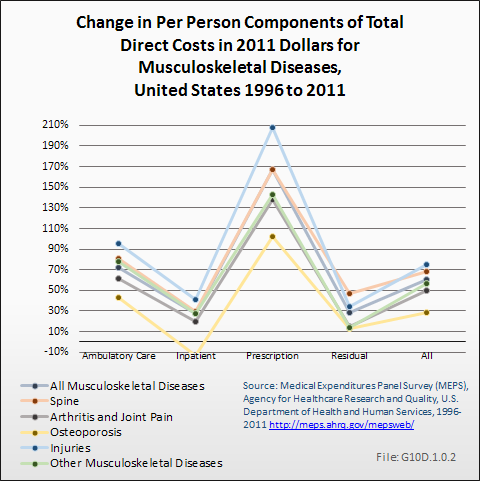
Incremental average expenditures for persons with musculoskeletal diseases almost doubled in real terms between 1996 to 1998 and 2009 to 2011, in 2011 dollars, from $1,280 in the earlier three-year period to $2,075 in the later one. Incremental costs for inpatient services for musculoskeletal diseases increased the most in relative terms, rising by 207% between 1996 and 2011. (Reference Table 10.5 PDF [3] CSV [4])
Data for specific musculoskeletal conditions has been analyzed through the 2009 to 2011 time period, and is shown in 2011 dollars. Total per person medical care expenditures rose for each of the major subconditions between 1996-1998 and 2009-2011. Osteoporosis, which rose from $8,572 to $10,978 per person had the lowest increase at 28%. Costs for injuries rose by 75%, from $4,053 to $7,104 per person, and was the largest relative due to increase. (Reference Table 10.4 PDF [1] CSV [2] and Table 10.7 PDF [5] CSV [6])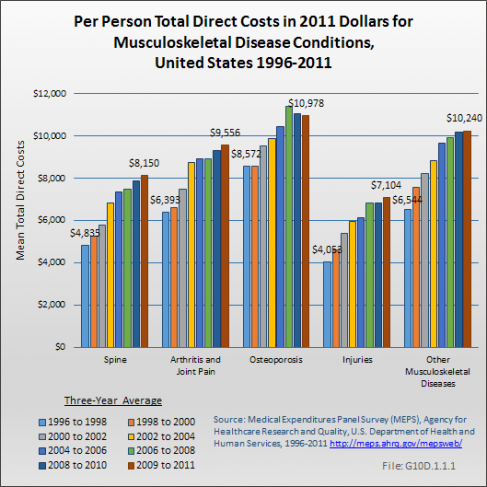
Incremental costs for arthritis and joint pain rose by 192% between 1996 and 2011, nearly four times the rate of increase for spine, injuries, and other musculoskeletal diseases. Incremental costs were not calculated for osteoporosis due to insufficient sample size. (Reference Table 10.5 PDF [3] CSV [4])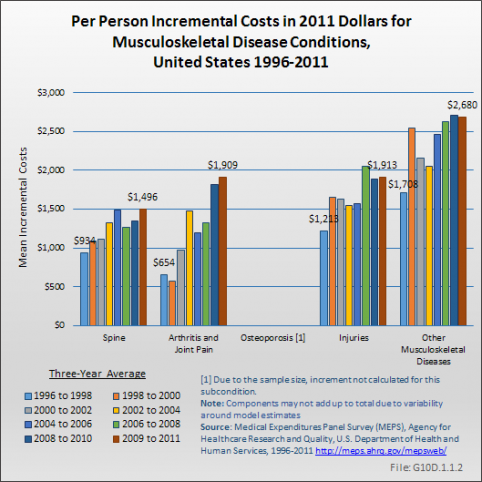
Expenditures for musculoskeletal diseases did not differ substantially by gender, race, and education level in 2011. On an unadjusted basis, women with musculoskeletal diseases had only 3% higher average expenditures than men. Nonwhites also had 3% higher expenditures than whites. On the other hand, non-Hispanics report 30% higher expenditures than Hispanics, and those who are married or divorced, separated, or widowed had substantially higher expenditures than those who have never married (presumably due to age). Persons who are divorced, widowed, or separated, at $8,951, had the highest unadjusted mean expenditures for musculoskeletal diseases.
Lack of insurance had the most profound impact on health expenditures for persons with musculoskeletal conditions. Expenditures on behalf of those without insurance, at $2,479, were only a third as large as those with private insurance ($7,842) and a quarter as much as those with public insurance ($10,142). Thus, lack of health insurance is associated with dramatically lower expenditure levels, inconsistent with the belief that persons who lack insurance are somehow able to obtain care. (Reference Table 10.8 PDF [7] CSV [8])
Total medical care expenditures for musculoskeletal diseases are disproportionately higher for persons 65 years of age or older, with a per-person cost of $11,708 in 2009 to 2011 compared to a per-person cost of $3,288 for persons less than 18 years, $4,658 for those 18 to 44 years, and $8,658 for those 45 to 64 years. (Reference Table 10.9 PDF [9] CSV [10])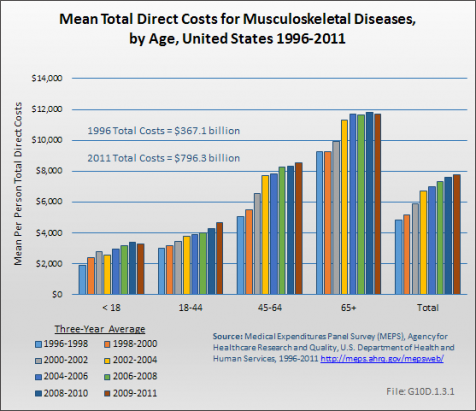
Although in the years 1996-1998, mean incremental costs for musculoskeletal disease were highest for the oldest cohort, age 65 years and older, by 1998 to 2000 costs for those ages 44 to 64 years were the highest. They have remained so since that time, and in 2009 to 2011 were 20% higher for this age group than the age 65 years and over group. (Reference Table 10.9 PDF [9] CSV [10] and Table 10.10 PDF [11] CSV [12])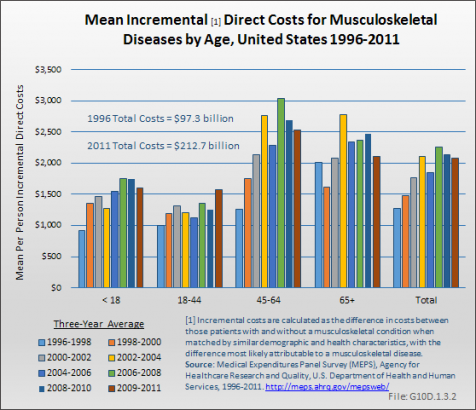
Links:
[1] https://bmus.latticegroup.com/docs/T10005.4.pdf
[2] https://bmus.latticegroup.com/docs/T10005.4.csv
[3] https://bmus.latticegroup.com/docs/T10006.5.pdf
[4] https://bmus.latticegroup.com/docs/T10006.5.csv
[5] https://bmus.latticegroup.com/docs/T10008.7.pdf
[6] https://bmus.latticegroup.com/docs/T10008.7.csv
[7] https://bmus.latticegroup.com/docs/T10009.8.pdf
[8] https://bmus.latticegroup.com/docs/T10009.8.csv
[9] https://bmus.latticegroup.com/docs/T10010.9.pdf
[10] https://bmus.latticegroup.com/docs/T10010.9.csv
[11] https://bmus.latticegroup.com/docs/T10011.10.pdf
[12] https://bmus.latticegroup.com/docs/T10011.10.csv